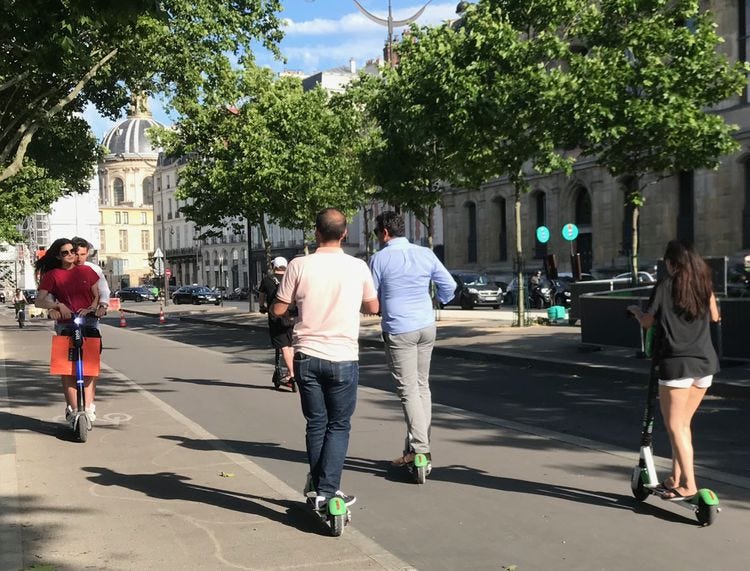The problem isn't dockless e-scooters, it's dockless cars
Paris has banned rental e-scooters, and many are cheering; I'm not.
After a referendum where 7.46% of eligible voters overwhelmingly rejected self-service e-scooters, Paris Mayor Anne Hidalgo has promised that she will not renew any contracts. "The voters have given us a clear road-map and we will follow it," said Hidalgo. "There will be no more self-service e-scooters in Paris." Many people around the world are cheering; American journalist Jill Filipovic writes:
“Over the past few years, electric scooters have been brought to Paris and dozens of other cities worldwide by various startups promising an environmentally-friendly individual transport option. What cities have gotten instead is chaos: scooters shooting down sidewalks at dangerous speeds or laying abandoned on pedestrian thoroughfares. Both riders and pedestrians have been injured and sometimes killed. Scooters sound great in theory. In practice, they’re much more of a menace than a convenience.”
But the reason people are shooting down sidewalks is that 80% of the road space is given to cars, leaving crumbs for people walking or using any form of micromobility. Let’s get it straight about what the real menace on the roads is.
I would point out that dockless cars parked on the sidewalk are a bigger problem than scooters, but nothing ever seems to be done about that. World Bank Transportation expert Daniel Moser says much the same thing:
Scooter companies are still banned in Toronto, where I live, with the city saying there is a "lack of city resources for enforcement and major challenges enforcing moving violations on sidewalks, parking obstructions and vandalism."This is in a city where the police admitted, in a report released after a senior cyclist was killed by a driver, they hadn't done traffic enforcement for years. And the chief then is now running for mayor. There is a complete obliviousness on the part of the anti-scooter people to the needs of anyone outside of a car.
Scooters are also geo-fenced and speed limited, and now often have to be parked in designated areas. Not many people are suggesting that this be done for dockless cars.
Scooters are also good for the environment; studies have shown that they replace replace cars. One commissioned by Lime found that scooters have lower emissions per kilometer traveled than anything but a private bike or e-bike. And this was done a few years ago; e-scooters today have even longer lives. Andrew Savage, Vice President and head of sustainability for Lime, emailed me his answer to my question about Paris:
"When you try to do new and innovative things, sometimes two steps forward accompany one step back. Thanks to investments by Lime, we're now as good for reducing carbon as most public transit rail systems per passenger kilometer and have a net impact of reducing carbon when incorporating all modes shifted by e-scooters or e-bikes (see Fraunhofer report). Paris is a real outlier as we see virtually every other city globally extending permits and expanding their shared programs. They seen the enormous carbon and mobility benefits of shared micromobility. We're of course hopeful shared e-scooters will continue to be a valuable car-alternative for Parisians beyond September and we'll continue to grow our e-bike business in Paris, which includes twice as many bikes as scooters today."
Climate activists in Paris are not thrilled with the ban either, Sylvain Delavergne, France coordinator for the Clean Cities Campaign, is quoted in Politico:
“As a result of this vote to ban self-service scooters, as of next September, nearly 10,000 more journeys will be made in motorized vehicles in the capital every day. The low participation — less than 8 percent of registered voters — means the results are not very representative of the preferences of Parisians, and of scooter users — from the provinces, as well as tourists — more broadly.”
I have used e-scooters in Paris, Marseille and Lisbon and found them incredibly convenient and useful, especially when there were big bike lanes that we could ride in. The problems arise when our sidewalks are littered with dockless cars and our bike lanes are full of dockless Fedex trucks. A 2020 study, Impeding access: The frequency and characteristics of improper scooter, bike, and car parking found that the e-scooters were not even close to being the worst offenders.
“Double parking and other vehicle parking practices such as blocking driveways, idling in bike lanes, and parking in designated ADA-accessible spaces without a proper placard have the potential to increase congestion and create safety hazards for other road users.”
Instead of banning e-scooters, we should be welcoming them, making room for them, and cracking down on those dockless cars. As Melinda Hansen, then head of sustainability at Bird, told me in an interview:
“We have to rethink our streetspace, creating what I have called micromobility lanes and she calls, much more aptly, 'green lanes'. If you look at the bulk of the injuries to scooter users, they come from being hit by cars. If you look at the biggest sources of complaints about scooters, it's that they are being used on sidewalks. It is no different from bikes, where riders are fighting for a safe place to ride.”
Gary Mason of the Globe and Mail suggests that bans are not going to work; the horse is out of the barn.
The reality is there is likely no going back now. The machines are here to stay. As the mayor of London, Sadiq Khan, said recently: “You can’t uninvent e-scooters.” In a world in which social planners are encouraging people to ditch their cars and get around in a more environmentally sustainable way, e-scooters would seem a viable alternative, one those same planners would likely want to encourage as a mode of transportation.
This is not the time to ban e-scooters; even the Mayor of Paris once said, "We need every tool in the box to get cars off the roads." Instead, we should build proper micromobility lanes and keep those damned dockless cars out of them.







I've done an awful lot of walking on sidewalks in the last 20 years and have yet to be run into by either a scooter or a bicyclist. A few bicyclists came close. No scooters have ever come close.
In the interest of safety and community-acceptance, E-bikes and E-scooters should include 2 user-selectible modes - street mode and sidewalk mode. Sidewalk mode would have a "safe" reduced maximum speed. Users would be advised to use sidewalk mode to easily limit speed when riding on sidewalks with pedestrian "congestion".
For perspective: I am a 76-year-old climate activist who, 3 years ago to minimize greenhouse gas emissions, put my automobile into storage in favor of walking and pedal-bicycling. I generally ride on the sidewalk to minimize my risk from automobiles. (Fact - injury and death by automobile are very real threats.) Seattle, my home town, has a decent bike-lane infrastructure, but, compared to bike lanes, sidewalks are one level futher distanced from automobiles.
Changing topic, go GreenBetween 13C-30C/55F-85F. Don't heat above 13C/55F. Don't cool below 30C/85F. Do it yourself. Tenaciously encourage others to do the same. https://greenbetween.home.blog